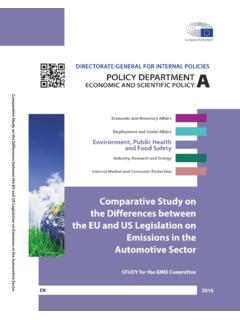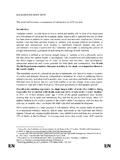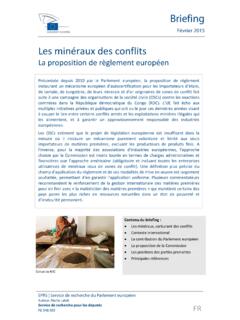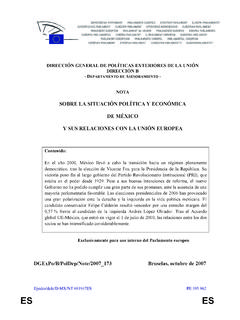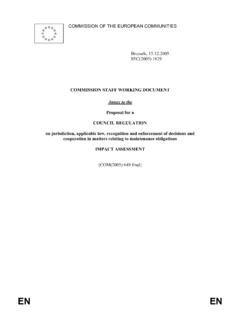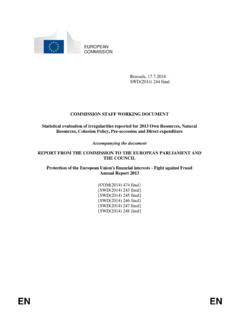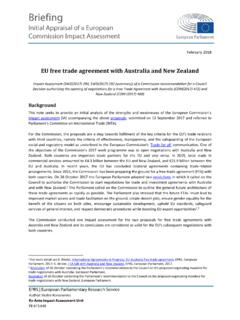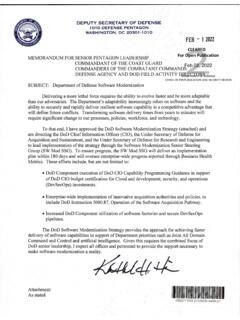Transcription of Artificial intelligence in transport - European Parliament
1 BRIEFING EPRS | European Parliamentary Research Service Author: Maria Niestadt with Ariane Debyser, Damiano Scordamaglia and Marketa Pape Members' Research Service PE March 2019 EN Artificial intelligence in transport Current and future developments, opportunities and challenges SUMMARY Artificial intelligence is changing the transport sector. From helping cars, trains, ships and aeroplanes to function autonomously, to making traffic flows smoother, it is already applied in numerous transport fields. Beyond making our lives easier, it can help to make all transport modes safer, cleaner, smarter and more efficient.
2 Artificial intelligence -led autonomous transport could for instance help to reduce the human errors that are involved in many traffic accidents. However, with these opportunities come real challenges, including unintended consequences and misuse such as cyber-attacks and biased decisions about transport . There are also ramifications for employment, and ethical questions regarding liability for the decisions taken by Artificial intelligence in the place of humans. The EU is taking steps to adapt its regulatory framework to these developments, so that it supports innovation while at the same time ensuring respect for fundamental values and rights.
3 The measures already taken include general strategies on Artificial intelligence and rules that support the technologies enabling the application of Artificial intelligence in transport . In addition, the EU provides financial support, in particular for research. In this Briefing Introduction EU action Artificial intelligence in road transport Artificial intelligence in aviation Artificial intelligence in railway transport Artificial intelligence in shipping, navigation and ports EPRS | European Parliamentary Research Service 2 Introduction Artificial intelligence (AI) is in the spotlight as one of the emerging fields transforming the transport sector.
4 It is not a new term. Academics talked about Artificial intelligence as early as the 1950s. Since then, AI has undergone a number of ups and downs, where optimistic expectations were followed by bitter disillusion. In recent years, AI has made a lot of progress, as machine learning techniques have been combined with technologies used for searching and analysing the large quantities of data (otherwise known as big data and data mining) produced by the development of the digital world. Other reasons for its successful growth include the development of communications networks and the internet of things,1 as well as progress in transport devices.
5 The future progress of AI in transport is expected to be even more spectacular, although there is no agreement on the timing and exact nature of these developments. There is no commonly agreed definition of AI, neither at the technical nor the legal/policy level. However, a plurality of definitions can be found. An American scientist, Marvin Minsky has defined it as 'the science of making machines or systems do things that would require intelligence if done by men', by the European Commission Joint Research Centre as 'any machine or algorithm that is capable of observing its environment, learning, and based on the knowledge and experience gained, take intelligent actions or propose decisions'.
6 And again by the European Commission as 'systems that display intelligent behaviour by analysing their environment and taking actions with some degree of autonomy to achieve specific goals'. AI does not refer to one technology but rather to a vast set of diverse approaches, methods and technologies, which to different degrees and in different ways show intelligent behaviour (such as logical reasoning, problem solving and learning) in various contexts. AI can be hardware based (for instance, in devices such as robots), or present in software (such as Google Maps).
7 Some of the key AI technologies are described in recent EPRS briefings on 'How Artificial intelligence works' and 'Understanding Artificial intelligence '. These briefings group the key AI technologies into three sections: symbolic AI, data-driven AI and future technologies. Symbolic AI includes systems where a human creates a succession of logical rules, transcribed in algorithms, which machines can follow to decide how to act in a given situation. Data-driven AI is an AI that combines machine learning techniques with technologies used for searching and analysing large quantities of data.
8 Future technologies include various developments where AI could display an even wider range of human capacities (such as creativity and intuition), or where AI outperforms humans. AI is helping to make all transport modes safer, cleaner, smarter and more comfortable. AI can be applied in vehicles, infrastructure, for drivers or transport users, and to the way in which these interact to deliver a transport service. AI helps to detect market trends; identify risks; ease traffic congestion; reduce greenhouse gas and air pollutant emissions; design and manage transport ; and analyse travel demand and pedestrian behaviour.
9 However, with the benefits of AI come real challenges. AI applications raise numerous ethical, social, economic and legal questions, such as who is liable for an accident; how to protect AI from cyber-attacks; or how to ensure data protection and transparency. AI also poses risks for citizens and consumers, as it can be used for surveillance purposes. AI can lead to biased decisions, restrict users' options, influence their opinions and manipulate their choices. Some analysts have raised concerns that AI could threaten jobs or render decision-making processes opaque.
10 EU action The European Union faces the question as to how to adapt its regulatory framework to these developments, so that it supports innovation while at the same time ensuring respect for EU's values and fundamental rights. The first steps have already been taken. The European Commission (responding to a call from the 28 leaders of the EU Member States), adopted a strategy paper on ' Artificial intelligence for Europe', complemented by a coordinated action plan on AI in April 2018. Artificial intelligence in transport 3 Both documents give examples of how AI is changing transport in the EU.
